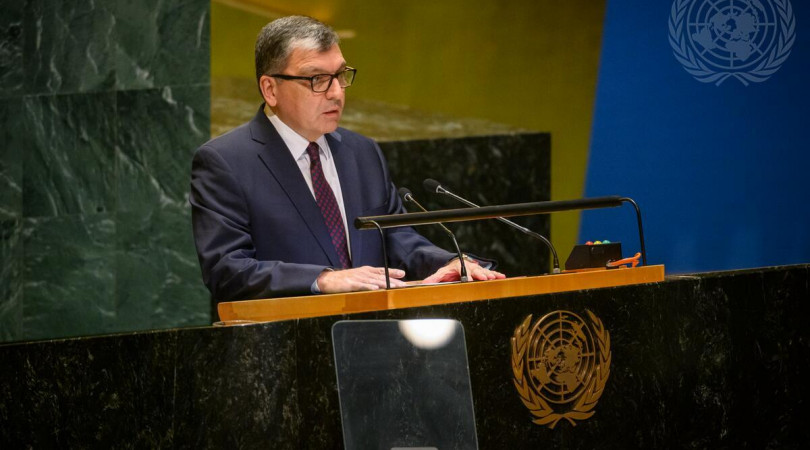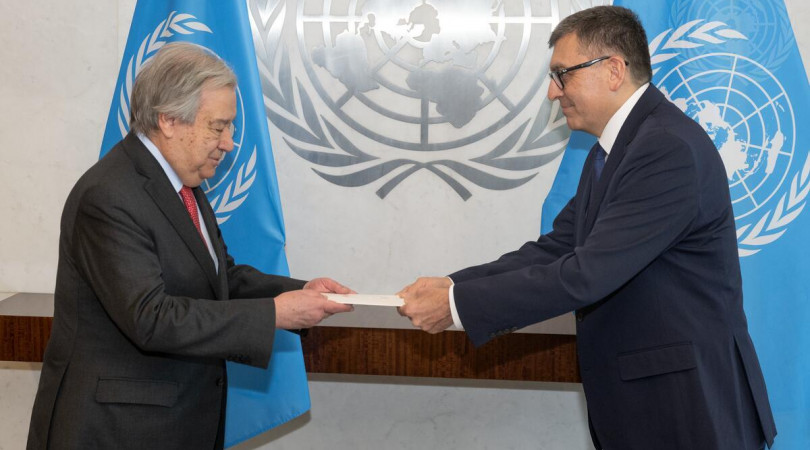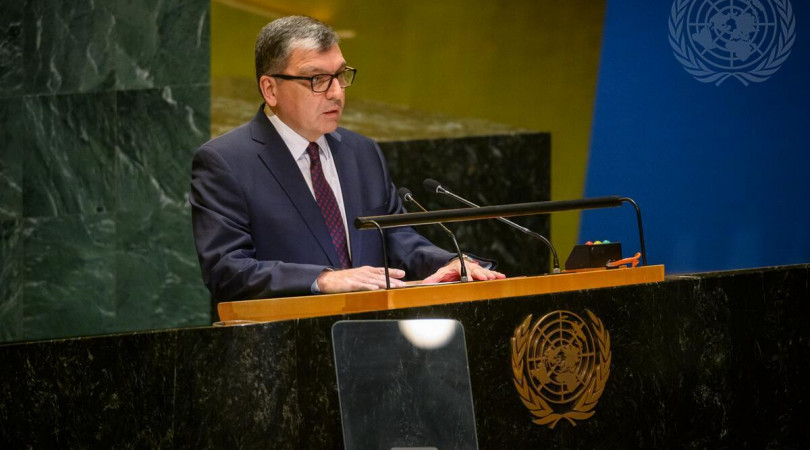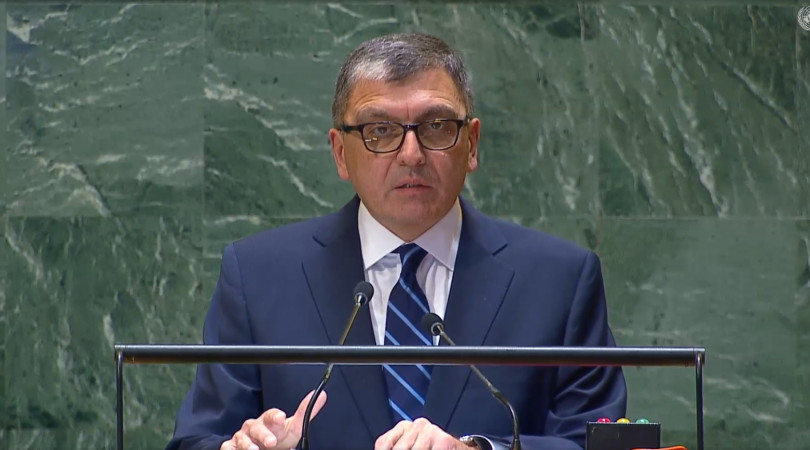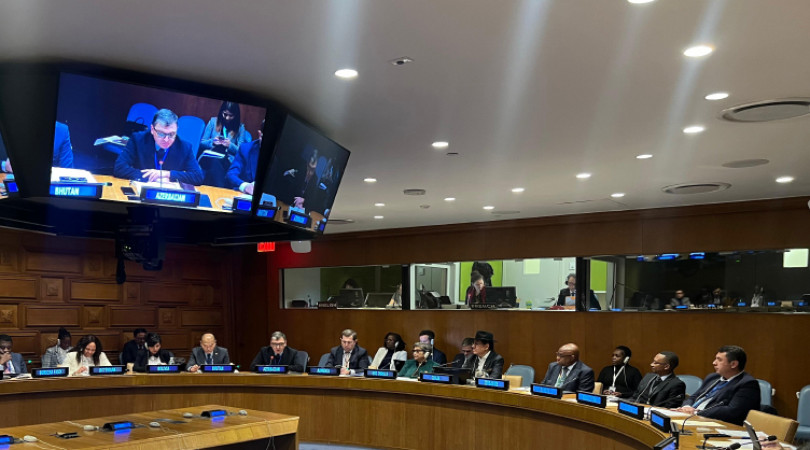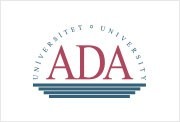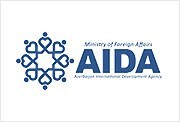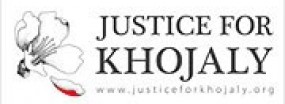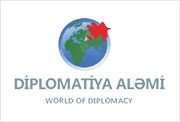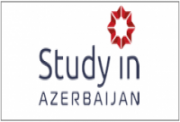Ilham Aliyev and First Lady Mehriban Aliyeva attend the opening ceremony of the Urban Planning and Architecture of Azerbaijan Forum
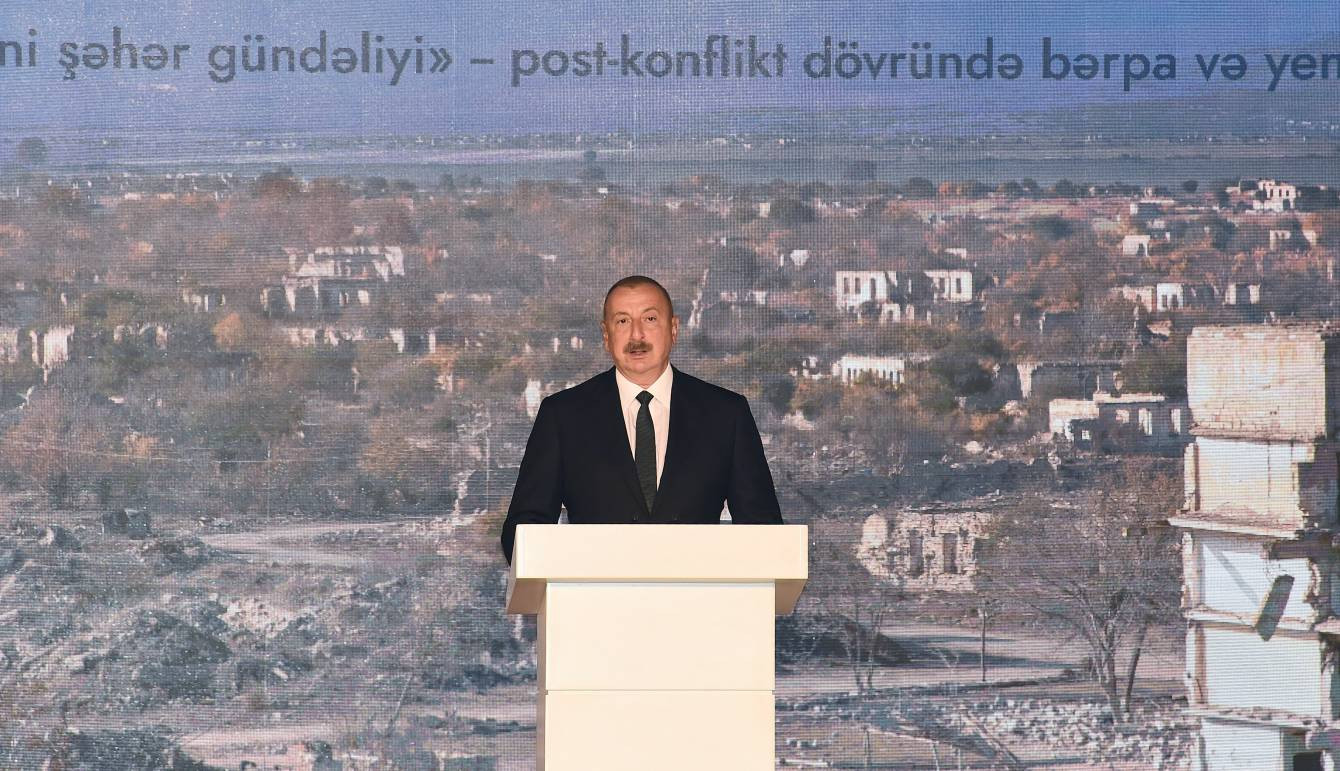
The Azerbaijan National Urban Forum on the “Sustainable Development Goals and the New Urban Agenda as engines of post-conflict reconstruction and rehabilitation” has got underway in Aghdam in partnership with the UN Human Settlements Programme (UN-HABITAT), the State Committee on Urban Planning and Architecture of Azerbaijan and with the organizational support of the ADA University.
President of the Republic of Azerbaijan Ilham Aliyev and First Lady Mehriban Aliyeva attended the Forum's opening ceremony.
The head of state delivered remarks at the event.
Remarks by the President Ilham Aliyev
Dear Executive Director of the United Nations Human Settlements Programme (UN-Habitat) Maimunah Mohd Sharif,
Dear guests,
Ladies and gentlemen.
Welcome to Aghdam. I am very glad we organized Azerbaijan National Urban Forum here, where Aghdam city was once situated. Now you can see nothing left from what used to be a city full of life. It was destroyed during the times of occupation. I’d also like to express gratitude to our guests from different countries. We have representatives of more than forty countries attending our Forum for being with us, for coming here to see what has happened to the biggest city in the Karabakh region, which Aghdam used to be and to see what we are doing and what we are planning to do in the coming years to return former IDPs to their homeland. Aghdam was, as I said, already destroyed during the years of occupation. It was not destroyed during the first Karabakh war. It was destroyed after almost 30 years, stone by stone. All the buildings have been ruined and dismantled. Stones have been stolen and sold out. You may see the only half-destroyed building was a building of Juma Mosque. Still, the reason why it was not destroyed along with other mosques which Armenians destroyed in the formerly occupied territories was that they were using the minarets for observation to see the potential movement of Azerbaijani armed forces. But we have video and photo evidence of the desecration of the Aghdam Mosque, where Armenians kept pigs and cows in the mosque. A total of 65 out of 67 mosques that existed in the liberated territories were totally destroyed. Two of them, one here and one in Shusha, were half destroyed and desecrated.
What you see here in Aghdam you can see in every single village in the Karabakh area. I know that our guests came here by plane to the newly-built Fuzuli Airport. So, Fuzuli city is totally destroyed, not a single building. Jabrayil is the same. Qubadli, and Zangilan are the same. The only places where not all the buildings have been destroyed were Shusha, Lachin and partly Kalbajar. But the reason for that was that the Armenian state was conducting a policy of illegal settlement of Armenians from different countries to settle on the occupied territories, and this is considered to be a brutal violation of international law and Geneva conventions. So now, we are facing a tremendous challenge to return as soon as possible former refugees and IDPs to their homeland. But one of the most significant complications apart from a large-scale reconstruction program is landmines. Since the war ended two years ago, almost two years ago, we have almost 250 Azerbaijanis who have been killed or seriously injured due to landmine explosions. Unfortunately, the figure is growing every week. Just last week, we had two killed and three seriously injured. Armenians planted more than one million mines during the times of occupation. And this policy of terror against Azerbaijan and the Azerbaijanis continues.
Relatively recently, we have discovered and neutralized more than 1.400 landmines that had been planted in the Lachin district by Armenian armed forces in the period after the second Karabakh war ended. So, aggression against Azerbaijan and terror against Azerbaijan continue. Our nation suffered a severe humanitarian crisis. Because as a result of Armenian aggression and occupation, more than one million Azerbaijanis were totally ethnically cleansed from their native land in Karabakh, Zangazur and also in today’s Armenia. And when it happened, the population of Azerbaijan was less than eight million people, and, can you imagine, one million became refugees and IDPs.
And we are very grateful to international organizations, especially institutions of the United Nations, for support to our refugees and IDPs, especially in the early years of independence when we needed the support seriously. The results of the Armenian occupation and aggression are now seen by everyone who visits the liberated territories. Since the Second Karabakh War ended, there have been thousands of foreign visitors, journalists, politicians, and representatives of civil society who came here and saw it with their own eyes. The scope of Armenian barbarism and vandalism is so impressive that many people who come to this part of Azerbaijan feel absolutely exhausted morally. And you can imagine the feelings of us, of Azerbaijanis and especially those who used to live in Aghdam, in Fuzuli in another part of Azerbaijan which was under occupation when they came here. They cannot even find the place where their house is situated because everything is totally destroyed. Armenia conducting the occupation policy had the main target to change the de facto situation on the ground and to make the negotiation process with Azerbaijan endless. That was the reason why negotiations lasted for 28 years without any results. The result was actually zero. Even though the leading international organizations such as the United Nations, the OSCE and others adopted resolutions and decisions demanding immediate and unconditional withdrawal of Armenian troops from Azerbaijani territories, particularly four UN Security Council resolutions which remained on paper for almost 30 years, and despite all our appeals to impose sanctions on Armenia we did not succeed. So, the international community decided to turn a blind eye to the humanitarian catastrophe of the Azerbaijani people. The most regrettable is that the structure which had a mandate from the OSCE, the so-called Minsk Group and its co-chairs visited occupied territories many times, witnessed the brutal devastation of all the cities and villages, and witnessed the illegal settlement of Armenians on our lands, but did not condemn Armenia. Throughout 28 years of their so-called activity, there was not a single word of condemnation of Armenia by them. Of course, now, when we see some efforts to revitalize this Minsk Group, we, of course, cannot be supportive of that because they did nothing to implement their mandate. The only thing they did, to a certain degree, they try to legitimize the Armenian aggression. They tried to create a balance between the aggressor and the victim of aggression.
Therefore, now, when Azerbaijan itself restored international law, implemented UN Security Council resolutions, used UN Charter, particularly the paragraph that talks about self-defense, and restored our national dignity, we do not need any other mediation. We made a proposal soon after the Second Karabakh War ended. Despite all that you see in Aghdam and what anyone can see in the territory of more than 10.000 square kilometers totally destroyed by Armenians, despite the human sufferings of our people, we proposed peace to Armenia. We announced publicly five basic principles of international law which should be the basis for the peace agreement, particularly mutual recognition of territorial integrity of countries, refrain from territorial claims in the future, refrain from the use of force or threat of use of force, delimitation of the state border and opening of communications. All these are the basic principles of international law, and I think peace agreements or any agreement between countries trying to normalize their relations must be based on that. With respect to the Armenian population, who still lives in the Karabakh region of Azerbaijan, are our citizens, and we are not going to discuss how we are going to organize their life on our territory with any international player. Karabakh is Azerbaijan. The Second Karabakh War proved it on the ground. During the times of occupation, no country in the world, including Armenia, recognized this artificial structure. Therefore, issues related to our internal affairs we never discuss with international institutions or with any country, regardless of the size and potential of that country.
We have certain optimism with respect to the peace process because just recently, several days ago, there was a meeting of foreign ministers of Azerbaijan and Armenia, the first meeting of that kind, particularly with the agenda of preparing the draft peace agreement. We hope that it will not take a long time. We know the tactics which Armenians usually use when they don’t want to come to an agreement, like the negotiations on the Karabakh conflict for 28 years. If that continues, then we will have no peace. If this is a choice of Armenia, they will make another grave mistake. They underestimated us, and they underestimated our will, the will of the people of Azerbaijan, and the potential of Azerbaijan. They had to pay the price for that. The war, which happened two years ago, was conducted on the territory of Azerbaijan. So, this once again proves our position and demonstrates that despite that, despite the suffering of more than a million of our countrymen, we want to put an end to hostility and mutual hatred, and we want to open a new page of peace. Whether we will succeed or not, we will see. I am not sure, but at least we are moving in that direction. At the same time, we have hopes that two corresponding commissions on border delimitation, the Azerbaijani and Armenian commissions, will not lose time either and work actively on defining the border between two countries which actually do not exist. During the times of occupation, which lasted for almost 30 years, that border was totally under Armenian control. So, when the occupation ended, we came to the border, which we considered the border and settled there. Therefore, to define this border which is more than 400 kilometers, of course, we need to have very active work based on historical documents, based on historical maps, and based on international practice and certain methodologies.
So, this process is moving, but again, it is difficult to say how successful it will be. So, this is actually what happened throughout the last period. Now we face new but very pleasant challenges to rebuild Karabakh and Eastern Zangazur, to return people, to return to life and to create for former refugees and IDPs much better conditions than anywhere else in Azerbaijan. And I am sure that these people deserve that. They lived in difficult conditions for many years despite the fact that we resettled more than 300 thousand IDPs providing them with new apartments and flats. And during numerous meetings with them when we were inaugurating these new housing projects, they were expressing gratitude for that but at the same time saying that we want you to return us. And I promised them all the time that I would do it, and I am very proud that we managed to do it. And already the program of Great Return has started. Relatively recently, this May, the first village in the Zangilan region was already built, and the first IDPs are already back. And I am very proud, and I am sure so are all the people of Azerbaijan, that not only those who used to live there are going back, but also their children, their grandchildren. This September, the school in Zangilan opened, and the young Zangilanis are already starting school. They have never seen that land. Because they were born after occupation, it shows that the people of Azerbaijan are strongly committed to their roots, to their native land. And really, it’s a source of national pride that based on the survey which we conducted among former IDPs with the question “are they going to go back or not” for us to know what should be the scale of the housing project, the absolute majority responded that they want to go back even those who had never seen those lands. So, this, of course, creates a very special atmosphere in our society and the feeling of national pride, the feeling of victory, the feeling of restoration of justice, restoration of the dignity of the people. These feelings cannot be measured by any scale. This is something which you have to feel. We feel it, and we are happy about that now. What we are doing here in Aghdam and other liberated territories is that we have concentrated and mobilized all our potential to return the former IDPs as soon as possible.
Large-scale infrastructure projects are underway. You have seen Fuzuli International Airport, which was built in 8 months. This month we plan to inaugurate Zangilan International Airport and, in 2025, International Airport in Lachin. The railroad from Barda to Aghdam will be operational next year. Yesterday I laid down the foundation of the new railway station. Thousands of kilometers of highways and thousands of kilometers of village roads are being constructed now. According to the investment plan, which has already been approved in the liberated territories of Karabakh and Eastern Zangezur, there will be 33 tunnels with a total length of more than 50 kilometers. There will be 84 bridges with a length of 12 km. These are only part of what we are now doing. We fully restored the electric supply to all the liberated areas. Hopefully, soon, in Jabrayil, we will start the construction of the solar power plant with a capacity of 230 megawatts.
In general, we have evaluated the potential of renewable energy in the liberated territories, and preliminary analysis shows it is almost 10.000 megawatt. We have already inaugurated several hydropower stations, and the total hydropower capacity will be more than 500 megawatts, and the rest will be solar and wind. This area will not only accumulate its people who had to live in different parts of Azerbaijan during the years of occupation but, at the same time, will be a driving force for Azerbaijan’s economy in the future. We have huge water resources here, which we have been deprived of during the times of occupation because Armenians did not only occupy our cities, they occupied our resources. There has been illegal mining and illegal activity of cutting us from water. We were not able to irrigate hundreds of thousands of hectares of land. So, now we are back to our rivers. We are back on our soil, and all the master plans of the cities have already been prepared by leading international companies and approved. So, we have already started here in Aghdam several housing projects. I was here yesterday for the groundbreaking ceremony of three villages, Khidirli, Kangarli, and Sarjilai. Several thousand people will live in these villages maximum in two years. In the city of Aghdam, we are already building a school for almost one thousand children, which will be ready maybe this year, maybe next year, a hospital and several housing projects. And this is only in Aghdam. At the same time, it is more or less happening in Fuzuli, Qubadli and Zangilan.
In the city of Lachin, where we returned just two months ago, we plan to restore it by the end of next year. Because, as I said, there was an illegal settlement there. So, not all the buildings have been knocked down. We have already sent a group of specialists there. So, we will rebuild Karabakh and Zangazur. We have no doubt about that. No matter how costly it will be, this is our national idea. Our national idea before was to return to our lands to restore justice and to restore our territorial integrity. All the people of Azerbaijan united and were preparing themselves for that. And the young generation who sacrificed their lives of almost three thousand victims we had during the war, and thousands of those who celebrated our victory, this is really modern Azerbaijan. This is new Azerbaijan. Azerbaijan, now which is free from that label of being occupied now, is just rising and will, I am sure, be one of the most successful countries not only in the region.
Once again, dear friends, ladies and gentlemen, thank you for being with us. This forum for us is really very important. I’m grateful to the Executive Director of UN-Habitat. She visited us six months ago, and we had a very good meeting with her. And afterward, we were invited to World Urban Forum in Poland, and our representatives participated. Now we are organizing National Urban Forum, and I am grateful to the UN representative for being with us, to the mayors and deputy mayors and to representatives from all the countries who are together with us. So, this is actually the beginning of international, I would say, ties of Aghdam.
We hope that Aghdam and many world cities will become sister cities. You know Aghdam, during the Soviet times, was the biggest city in Karabakh, a city full of life. Everybody in Azerbaijan knows it. After we liberated the territories and foreign experts and journalists came here, they gave several names to Aghdam. One was a victim of Urbicide, which is absolutely correct, and the other was a “ghost city”, also absolutely correct, and also it was named “Hiroshima of the Caucasus.” But unlike Hiroshima, the devastation and demolition were not a result of an atomic bomb. But it was a result of the vandalism and barbarism of our neighbors. But now we are back, and we came back by force. We came back using international law norms, and we came back to live here and to live here forever. Thank you.

